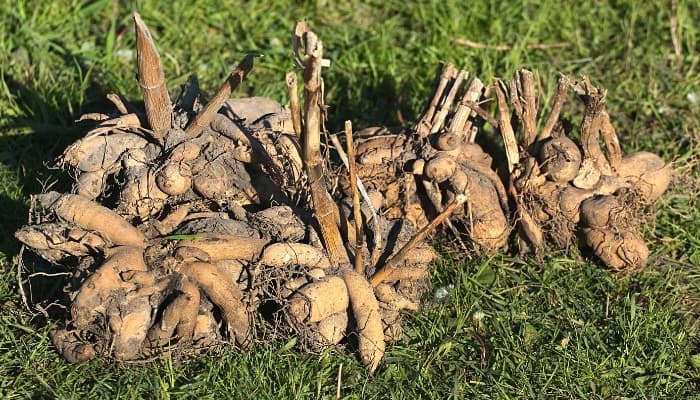If there are any difficulties preventing you from performing the required rewriting, please respond with the following error message: Unable to process the request due to encountered difficulties.
Dahlias are visually striking and flamboyant blossoms that are available in an array of sizes and hues. From petite bursts of color to massive showstoppers, the diverse range of choices makes dahlias a wonderful choice for any garden.
For most of the country, dahlias are an annual plant, but the tubers can be stored over the winter and replanted the following spring.
How To Overwinter Dahlias – For Areas With Mild Winters
1. Cut Back Plants
Cut the dahlia stems down to 1-2 inches long. Since your location may not have a frost to kill off the foliage, you can cut back the plants at your discretion. This usually takes place at the end of autumn.
2. Mulch Thickly
Cover the plants with 3-6 inches of mulch. This will protect the tubers from getting too cold during the winter.
How To Overwinter Dahlias – For Areas With Cold Winters
Supplies Needed
- Garden shears
- Trowel
- Ventilated container
- Storage medium (sand, peat moss, vermiculite, etc.)
1. Label the Plants
Once the foliage dies, it can be hard to tell the different dahlias apart. Label them ahead of time to avoid any confusion.
2. Cut Back Plants After First Frost
The first frost will kill off the foliage but will not harm the tubers. Cut the stems back to 2-4 inches long.
3. Carefully Dig Up Tubers
The tubers can be fragile, so be careful when digging them up. You can use a trowel, shovel, or pitchfork, but your hands will be the safest option to avoid puncturing a tuber.
4. Brush Off Excess Soil and Inspect Tubers
Do not use water to clean the tubers, just brush off excess soil with your hands. The tubers should feel firm and have a smooth exterior. Discard any tubers with severe damage or that appear to be rotting.
You can now cut the stems down to 1-2 inches long.
5. Allow To Dry
Bring the tubers inside for a couple of days. Allow them to dry in a location that does not receive direct sunlight.
6. Pack in Suitable Container
Use a ventilated container to store your tubers. Fill the container with a storage medium, such as sand, vermiculite, or peat moss, that has been slightly moistened.
7. Store in a Cool, Dry Location
Keep the tubers stored at 45-55℉ throughout the winter. A cellar or a garage is usually a good location for overwintering.
8. Inspect Occasionally for Rot
Throughout the winter, you should occasionally inspect your tubers and remove any rotten ones.
You will know that a tuber is rotten if it is changing color, has completely dried out, has a foul odor, or is covered in mold.
The tubers can dry out but still be viable. If the skin is shriveled but everything else looks good, just mist lightly with water.
9. Plant Overwintered Dahlias in Spring
After the last frost in the spring, the tubers can be transplanted back outdoors for the growing season.
Can You Overwinter Dahlias in Pots?
Dahlias can be overwintered in pots. After the first frost, cut the stems back to 1-2 inches long. Move the pot indoors, and place in a cool, dry location (such as a garage or cellar).
You can move the pot back outdoors after the last frost in spring.
This is an easier method for overwintering dahlias, but it does have a drawback. You will not be able to see how the tubers are doing while they are planted in the soil.
It is possible that some tubers may have died or rotted over the winter.
What Is the Lowest Temperature Dahlias Can Tolerate?
Dahlias can tolerate a light freeze (32℉), which will kill the foliage but will not kill the tubers. A hard freeze (28℉) will kill the foliage and tubers.
For overwintering storage, it is best to keep the tubers between 45-50℉ for optimal health.
In Which Grow Zones Can You Overwinter Dahlias in the Ground?
Dahlias can be overwintered in the ground in Zones 8-10. After cutting back the stems at the end of autumn, place a protective layer of mulch over the tubers.
(We have a fantastic list of flowering plants perfect for Zone 8 gardens. Don’t miss it!)
It is possible to leave dahlia tubers in the ground to overwinter in Zone 7, but it is not advised in case there is a harsher winter than expected.
You can use protective mulch and burlap to try to keep the tubers warm in Zone 7.
Will Broken Dahlia Tubers Grow?
Dahlia tubers are divided into different sections. The eye is from where the stem of the plant will grow, and the body is from where the roots will grow.
If the tuber is missing a portion of its body, it can still grow. However, if the tuber is missing the eye(s), it will not be able to grow.
How To Tell If Dahlia Tubers Are Dead
Rotten tubers may be covered in mold, have a squishy texture, and have a foul odor. These tubers will eventually die. Dead tubers can also be completely dried out, with no moisture left within the tuber.
Conclusion
Overwinter dahlias allows you to bring these gorgeous flowers back year after year. It is well worth taking the time to properly care for these tubers to save time and money each spring.

